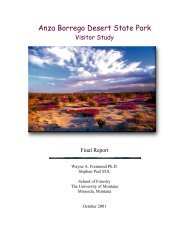Final Mitigated Negative Declaration and Response to Comments
Final Mitigated Negative Declaration and Response to Comments
Final Mitigated Negative Declaration and Response to Comments
You also want an ePaper? Increase the reach of your titles
YUMPU automatically turns print PDFs into web optimized ePapers that Google loves.
LAHONTAN REGIONAL WATER QUALITY CONTROL BOARD (LRWQCB) RESPONSE<br />
GENERAL COMMENT ON PREPARATION OF A HACCP<br />
Preparation of a Hazard Analysis <strong>and</strong> Critical Control Point (HACCP) plan should be an<br />
element of risk management that is built in<strong>to</strong> the project.<br />
RESPONSE<br />
Mitigation Measure Hydro-1: Water Quality states that underwater AC control activities in<br />
Lake Tahoe require permits from the Army Corps of Engineers, Lahontan Regional Water<br />
Quality Control Board, Tahoe Regional Planning Agency, <strong>and</strong> the California Department of<br />
Fish <strong>and</strong> Game. All of these permits require moni<strong>to</strong>ring <strong>and</strong> protective measures <strong>to</strong> ensure<br />
that project activities do not result in significant impacts <strong>to</strong> water quality. Project activities will<br />
not commence until all required permits are attained.<br />
To prevent impacts <strong>to</strong> Lake Tahoe from inadvertent movement or introduction of non-target<br />
species, regula<strong>to</strong>ry agencies in the Lake Tahoe basin are now requiring preparation <strong>and</strong><br />
adherence <strong>to</strong> a Hazard Analysis <strong>and</strong> Critical Control Point (HACCP) plan. HACCP planning is<br />
an international st<strong>and</strong>ard for reducing or eliminating the spread of unwanted species during<br />
specific processes or practices, such as delivery, removal, <strong>and</strong> installation of benthic barriers.<br />
The Water Quality Control Plan for the Lahontan Region (LRWQCB 1994 Chapter 5: Water<br />
Quality St<strong>and</strong>ards <strong>and</strong> Control Measures for the Lake Tahoe Basin) has designated beneficial<br />
uses for the surface waters of the Lake Tahoe Hydrologic Unit, such as Cold Freshwater<br />
Habitat. HACCP planning will be a permit requirement of this project <strong>and</strong> this planning will help<br />
protect these beneficial uses.<br />
COMMENTS ON PROJECT DESCRIPTION AND IMPLEMENTATION, SECTION 2.5<br />
WEED FREE STRAW COMMENT<br />
The IS/MND explains that one alternative method involves the placement of straw (organic<br />
matter) under the barriers. If this method is used, the organic matter (straw) that is used must<br />
be certified weed free <strong>to</strong> eliminate the introduction of potential non-native <strong>and</strong> invasive weeds.<br />
The use of certified weed free straw should be identified as a control measure in the HACCP<br />
(detailed above).<br />
RESPONSE<br />
The HACCP developed as a permit requirement for res<strong>to</strong>ration work in Lake Tahoe <strong>to</strong> control<br />
Asian clams (see response above) will require the use of certified weed free straw if organic<br />
matter is used <strong>to</strong> augment benthic barriers. Mitigation Measure Hydro-1 requires that project<br />
activities attain permits from regula<strong>to</strong>ry agencies in the basin <strong>and</strong> this requirement of use of<br />
weed free straw or other organic matter will be a condition of this mitigation measure.<br />
FREEZING CLAMS COMMENT<br />
More detail is required for the LRWQCB <strong>to</strong> assess potential impacts of pilot testing of<br />
technology <strong>to</strong> freeze clams in place in the lake sediment.<br />
RESPONSE<br />
11<br />
Asian Clam Control Project<br />
<strong>Final</strong> <strong>Mitigated</strong> <strong>Negative</strong> <strong>Declaration</strong> <strong>and</strong> <strong>Response</strong> <strong>to</strong> <strong>Comments</strong>
















